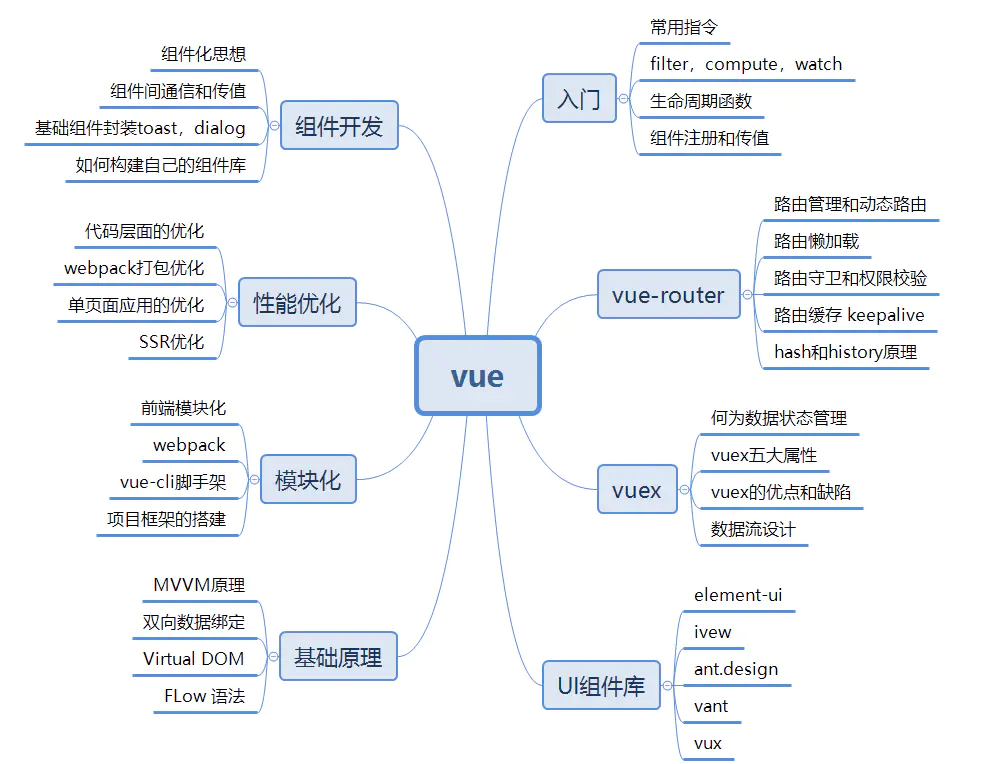vue 作为目前前端三大框架之一,对于前端开发者可以说是必备技能。那么怎么系统地学习和掌握 vue 呢?为此,我做了简单的知识体系体系总结,不足之处请各位大佬多多包涵和指正,如果喜欢的可以点个小赞!本文主要讲述一些vue开发中的几个高级应用,希望能对大家有所帮助。
相关推荐
总结vue 知识体系之基础入门篇
总结vue知识体系之实用技巧
总结几个vue-router的使用技巧
搭建一个vue-cli的移动端H5开发模板
Vue.use
我们使用的第三方 Vue.js 插件。如果插件是一个对象,必须提供install方法。如果插件是一个函数,它会被作为install方法。install方法调用时,会将Vue作为参数传入。该方法需要在调用new Vue()之前被调用。
我们在使用插件或者第三方组件库的时候用到Vue.use这个方法,比如
import iView from 'iview'
Vue.use(iView)那么Vue.use到底做了些什么事情呢?我们先来看一下源码
import { toArray } from '../util/index'
export function initUse(Vue: GlobalAPI) {
Vue.use = function(plugin: Function | Object) {
const installedPlugins = this._installedPlugins || (this._installedPlugins = [])
if (installedPlugins.indexOf(plugin) > -1) {
return this
}
// additional parameters
const args = toArray(arguments, 1)
args.unshift(this)
if (typeof plugin.install === 'function') {
plugin.install.apply(plugin, args)
} else if (typeof plugin === 'function') {
plugin.apply(null, args)
}
installedPlugins.push(plugin)
return this
}
}我们由以上可以看出,plugin参数为函数或者对象类型,首先Vue会去寻找这个插件在已安装的插件列表里有没有,如果没有,则进行安装插件,如果有则跳出函数,这保证插件只被安装一次。
接着通过toArray方法将参数变成数组,再判断plugin的install属性是否为函数,或者plugin本身就是函数,最后执行plugin.install或者plugin的方法。
举个例子
下面我们来举个实际例子
1、编写两个插件
const Plugin1 = {
install(a) {
console.log(a)
}
}
function Plugin2(b) {
console.log(b)
}
export { Plugin1, Plugin2 }2、引入并 use 这两个插件
import Vue from 'vue'
import { Plugin1, Plugin2 } from './plugins'
Vue.use(Plugin1, '参数1')
Vue.use(Plugin2, '参数2')此时我们运行项目代码就可以用到上面两个插件了。
Vue.mixin
混入 (mixin) 提供了一种非常灵活的方式,来分发 Vue 组件中的可复用功能。一个混入对象可以包含任意组件选项。当组件使用混入对象时,所有混入对象的选项将被“混合”进入该组件本身的选项。
1、定义一个 mixin.js
export default mixin {
data() {
return {
name: 'mixin'
}
},
created() {
console.log('mixin...', this.name);
},
mounted() {},
methods: { //日期转换
formatDate (dateTime, fmt = 'YYYY年MM月DD日 HH:mm:ss') {
if (!dateTime) {
return ''
}
moment.locale('zh-CN')
dateTime = moment(dateTime).format(fmt)
return dateTime
}
}
}2、在vue文件中使用mixin
import '@/mixin'; // 引入mixin文件
export default {
mixins: [mixin], //用法
data() {
return {
userName: "adimin",
time: this.formatDate(new Date()) //这个vue文件的数据源data里面的time就是引用混入进来的方法
}
}
} 或者在全局中使用在main.js中,所有页面都能使用了
import mixin from './mixin'
Vue.mixin(mixin) 合并选项
当组件和混入对象含有同名选项时,这些选项将以恰当的方式进行“合并”。
-
data对象在内部会进行递归合并,并在发生冲突时以组件数据优先。 - 同名钩子函数将合并为一个数组,因此都将被调用。混入对象的钩子将在组件自身钩子之前调用。
- 值为对象的选项,例如
methods、components和directives,将被合并为同一个对象。两个对象键名冲突时,取组件对象的键值对。
Vue.extend
Vue.extend 属于 Vue 的全局 API。它使用基础 Vue 构造器,创建一个“子类”。参数是一个包含组件选项的对象。如下:
<div id="app"></div>
var Profile = Vue.extend({
template: '<p>{{firstName}} {{lastName}}</p>',
data: function () {
return {
firstName: 'Walter',
lastName: 'White'
}
}
})
// 创建 Profile 实例,并挂载到一个元素上。
new Profile().$mount('#app')应用实例
我们常用 Vue.extend 封装一些全局插件,比如 toast, diolog 等。
下面以封装一个 toast 组件为例。
1、编写组件
- 根据传入的 type 确定弹窗的类型(成功提示,失败提示,警告,加载,纯文字)
- 设置弹窗消失的时间
<template>
<div>
<transition name="fade">
<div class="little-tip" v-show="showTip">
<img src="/success.png" alt="" width="36" v-if="type=='success'" />
<img src="/fail.png" alt="" width="36" v-if="type=='fail'" />
<img src="/warning.png" alt="" width="36" v-if="type=='warning'" />
<img src="/loading.png" alt="" width="36" v-if="type=='loading'" class="loading" />
<span>{{msg}}</span>
</div>
</transition>
</div>
</template>
<script>
export default {
data() {
return {
showTip: true,
msg: '',
type: ''
}
},
mounted() {
setTimeout(() => {
this.showTip = false
}, 1500)
}
}
</script>
<style lang="less" scoped>
/* 样式略 */
</style>2、利用 Vue.extend 构造器把 toast 组件挂载到 vue 实例下
import Vue from 'vue'
import Main from './toast.vue'
let Toast = Vue.extend(Main)
let instance
const toast = function(options) {
options = options || {}
instance = new Toast({
data: options
})
instance.vm = instance.$mount()
document.body.appendChild(instance.vm.$el)
return instance.vm
}
export default toast3、在 main.js 引入 toast 组价并挂载在 vue 原型上
import Vue from 'vue'
import toast from './components/toast'
Vue.prototype.$toast = toast4、在项目中调用
this.$toast({ msg: '手机号码不能为空' })
this.$toast({
msg: '成功提示',
type: 'success'
})Vue.extend 和 Vue.component 的区别
-
component是需要先进行组件注册后,然后在template中使用注册的标签名来实现组件的使用。Vue.extend则是编程式的写法。 - 控制
component的显示与否,需要在父组件中传入一个状态来控制或者在组件外部用v-if/v-show来实现控制,而Vue.extend的显示与否是手动的去做组件的挂载和销毁。
Vue.directive
注册或获取全局指令。指令定义函数提供了几个钩子函数(可选):
- bind: 只调用一次,指令第一次绑定到元素时调用,可以定义一个在绑定时执行一次的初始化动作。
- inserted: 被绑定元素插入父节点时调用(父节点存在即可调用,不必存在于 document 中)。
- update: 被绑定元素所在的模板更新时调用,而不论绑定值是否变化。通过比较更新前后的绑定值。
- componentUpdated: 被绑定元素所在模板完成一次更新周期时调用。
- unbind: 只调用一次, 指令与元素解绑时调用。
应用实例
下面封装一个复制粘贴文本的例子。
1、编写指令 copy.js
const vCopy = {
bind (el, { value }) {
el.$value = value // 用一个全局属性来存传进来的值
el.handler = () => {
if (!el.$value) {
alert('无复制内容')
return
}
// 动态创建 textarea 标签
const textarea = document.createElement('textarea')
// 将该 textarea 设为 readonly 防止 iOS 下自动唤起键盘,同时将 textarea 移出可视区域
textarea.readOnly = 'readonly'
textarea.style.position = 'absolute'
textarea.style.left = '-9999px'
// 将要 copy 的值赋给 textarea 标签的 value 属性
textarea.value = el.$value
// 将 textarea 插入到 body 中
document.body.appendChild(textarea)
// 选中值并复制
textarea.select()
// textarea.setSelectionRange(0, textarea.value.length);
const result = document.execCommand('Copy')
if (result) {
alert('复制成功')
}
document.body.removeChild(textarea)
}
// 绑定点击事件,就是所谓的一键 copy 啦
el.addEventListener('click', el.handler)
},
// 当传进来的值更新的时候触发
componentUpdated (el, { value }) {
el.$value = value
},
// 指令与元素解绑的时候,移除事件绑定
unbind (el) {
el.removeEventListener('click', el.handler)
}
}
export default vCopy2、注册指令
import copy from './copy'
// 自定义指令
const directives = {
copy
}
// 这种写法可以批量注册指令
export default {
install (Vue) {
Object.keys(directives).forEach((key) => {
Vue.directive(key, directives[key])
})
}
}3、在 main.js 引入并 use
import Vue from 'vue'
import Directives from './JS/directives'
Vue.use(Directives)这样就可以在项目直接用 vCopy 指令了。
推荐文章
从零开始构建一个webpack项目
总结几个webpack打包优化的方法
总结前端性能优化的方法
几种常见的JS递归算法
封装一个toast和dialog组件并发布到npm
一文读尽前端路由、后端路由、单页面应用、多页面应用
浅谈JavaScript的防抖与节流
关注的我的公众号不定期分享前端知识,与您一起进步!


**粗体** _斜体_ [链接](http://example.com) `代码` - 列表 > 引用。你还可以使用@来通知其他用户。